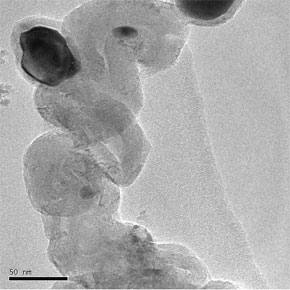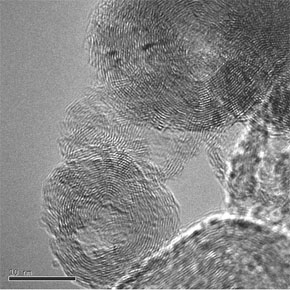| Posted: Apr 27, 2006 | |
A practical method for the production of hollow carbon onion nanoparticles |
|
| (Nanowerk Spotlight) Carbon onions, which are made of concentric graphene spherical shells, are one of the possible carriers of the 217.5 nm interstellar absorption bump. They are also a potential solid lubricant similar to Tungstenite (WS2) nanoparticles having an onion-like structure. In addition, carbon onion nanoparticles are expected to have good prospects for other applications, such as the reinforcement of composite materials, magnetic storage media and wear-resistant materials. | |
| Current techniques applied to fabricating hollow carbon onions, such as the dc arc-discharge, high-energy electron irradiation of carbonaceous materials, thermal treatment of fullerene black, and shock-wave treatment of carbon soots, can only be used to prepare a small quantity of hollow carbon onions or carbon onions with a mass of by-products, which are hardly separated from the product. Thus the investigation and possible application of carbon onions appear not very promising. | |
| My research group at Tianjin University recently found a method for obtaining pure carbon onion nanoparticles in large quantities. We describe a practical method for the fabrication of hollow carbon onions by using nitric acid to dissolve the nickel from the carbon-coated nickel nanoparticles. In this method, the decomposition of methane in the presence of Ni/Al catalyst particles produces carbon nano-onions as the primary product. And the nanoparticles with nickel nanoparticle encapsulated are very easily purified to be hollow onions by the subsequent nitric acid treatment. | |
| The method requires a relatively low energy input with the correct choice of catalyst precursor and purification time, thus making it industrially attractive. Previously, the lack of a suitable amount of carbon nano-onions has restricted the development of their applications, however we believe the described method is suitable for large-scale production. | |
| Together with first author Chunnian He and co-authors Chunsheng Shi, Xiwen Du, and Jiajun Li all from Tianjin University, we describe our recent work in an article titled "A practical method for the production of hollow carbon onion particles", published in the March 3, 2006 online edition of Journal of Alloys and Compounds. | |
  | |
| (a) TEM image of the original carbon nanomaterials. It can be seen that the original carbon nanomaterials contain carbon onions with a hollow core and carbon-encapsulated metal nanoparticles; (b) TEM image of the purified carbon onions with core empty. (Source: Professor Zhao, Tianjin University) | |
| The research in my group is directed towards the synthesis, characterization and applications of carbon nanomaterials. The team has worked specifically on carbon nanotubes reinforced metal (Al or Cu) matrix composite and magnetic biologic nanoparticles since 2005. In 2006, we reported our work related to the "Low-temperature synthesis of carbon onions by chemical vapor deposition using a nickel catalyst supported on aluminum" in Scripta Materialia. Recently, one of our subsequent work, "Amorphous carbon nanotubes fabricated by low-temperature chemical vapor deposition", accepted by Carbon (in press). | |
| By Professor Naiqin Zhao, School of Materials Science and Engineering, Tianjin University, PR China. | |
Become a Spotlight guest author! Join our large and growing group of guest contributors. Have you just published a scientific paper or have other exciting developments to share with the nanotechnology community? Here is how to publish on nanowerk.com.
